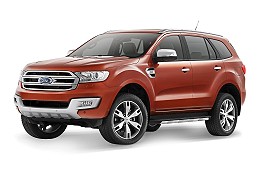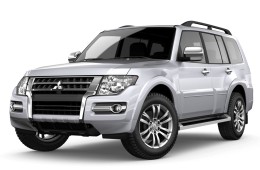|
|
VS |
|
Welcome to our comparison of the Mitsubishi Pajero vs Ford Everest comparison for 2019. Since the Pajero in it’s current guise is probably the last one we decided to see how it compares to the latest large SUVs current available. Whether there will be a new generation Pajero is not known. The Ford Everest has been around for a few years and takes on being a genuine off roader. With a small price decrease and updated specification it is worth a second look. Which is the better one to buy?
Mitsubishi Pajero vs Ford Everest exterior comparison : The Pajero is a nice looking, conservative and stereotypically a large SUV. Unfortunately they put too much chrome. The Pajero is an old design but it has stood the test of time without raging too badly. The Ford Ranger uses the same concept and it’s an even more conservative design, to the point of being a two boxes with a cheap looking rear end. Ford says they paid lots of money to develop it but clearly it wasn’t on talented exterior designers.
Mitsubishi Pajero vs Ford Everest interior comparison : Since the Everest is based on the Ford Ranger Ute and in turn based on the Mazda BT-50 there is lots of space inside. In comparison the Pajero has lots of space too but not as much. The Everest interior may be modern in terms of the driving environment but the passengers don’t have much to look at, thankfully there are large windows. Although spartan the Everest is comfortable and quiet.
Mitsubishi Pajero vs Ford Everest engines and technology comparison : We’s like to point out key differences in the engine department between the two and that the bigger 5 cylinder turbo diesel in the Ranger makes more power for a less frantic drive. Even more so with the twin turbo diesel and the 10 speed automatic eventually as an option. In comparison the Pajero is pretty decent too but clearly the old tech. Designed when fuel consumption was not absolute priority it’s 5 speed means it moves nicely without the lag in the Everest. More safety tech in the Everest means it also win this part of the comparison. However you may notice that something is amiss that a 10 plus year old engine is almost just as good as a new twin turbo diesel. You can blame emissions regulations and arguably low tech threshold in the Ford. Furthermore the Pajero has the better stereo system compared to the ordinary sounding and not upgradeable system in the Everest.
Mitsubishi Pajero vs Ford Everest street cred comparison : The Pajero will always have the Dakar rally wins for the 80’s and 90’s and for being the first of the modern SUV configuration. However the baby boomer generation that kept the Pajero of sale upgrading to Land Cruisers it will always have the 2nd best rating. This leaves the Ford Everest as a wanna to be in the street cred stakes. It’s tough to build a reputation from essentially nothing but press releases.
The winner of the Mitsubishi Pajero vs Ford Everest comparison is the Ford Everest. The Everest wins the Spec and technical comparison easily but that is all. Drive one and you’ll realise that it is a big wagon that is boring to drive and has difficulty with the challenges of nimble urban cars and SUVs. There is no character in the design to comment. Together with it’s expensive price tag and lack of street cred you’ll be left wondering whether it was all worth it when you compare cheaper SUVs that have more than just marketing behind the brand. Using brains to decide which one to buy, will pick the Ford Everest but those with a heart as well will probably choose the last of it’s kind and buy the Mitsubishi Pajero and be just as happy.
| Ford Everest |
Mitsubishi Pajero |
 |
 |
| Engines | |
| IL5 Cylinder Diesel Turbo-charged – Intercooler Direct Injection – Common Rail 3.2 Litre (3198cc) Claimed 143Kw @ 3000 RPM Claimed 470Nm @ 1450 RPM |
IL4 Diesel DOHC 16 valve Turbo charged with intercooler Direct injection 3.2 Litre (3200cc) Claimed 118Kw @3800RPM (Manual) Claimed 125Kw @2000RPM (Auto) 381Nm @ 2000RPM (Manual) 373Nm @ 2000RPM (Auto) 2009 UPGRADE 147Kw @ 3800RPM 441Nm @ 2000RPM |
| IL4 Cylinder Diesel Twin Turbo – Intercooler Direct Injection – Common Rail 2.0 Litre (1996cc) Claimed 157Kw @ 3750 RPM Claimed 500Nm @ 1750 RPM |
|
| Weight | |
| Kerb weight FROM 2370Kg Towing capacity up to 3100Kg |
Kerb weight 1900Kg Towing capacity up to 3000Kg |
| Fuel capacity & consumption | |
| Up to 80 litres IL5 Diesel 8.5 litres per 100km (Auto) IL4 Twin Turbo 7.1 litres per 100km (Auto) |
88 litres V6 Petrol 13.5(M) 13.7(A) litres per 100km IL4 Diesel 9.2(M) 10.6(A) litres per 100km |
| Other specifications | |
| 6 or 10 speed Auto Overall height/width 1837/1860 Overall length/wheelbase 4892/2850 NCAP safety rating 5/5 |
5 speed Auto Overall height/width 1900/1875 Overall length/wheelbase 4900/2780 Track (front/rear) 1570/1570 NCAP safety rating 4/5 |
| Capability | |
| Angle of: (degrees) Approach 20 Departure 24 Breakover 23 Minimum ground clearance 227 mm Water Fording depth 800mm Max 4WD system: 4WD with low range |
Angle of: (degrees) Approach 36.6 Departure 25 Breakover 23 Minimum ground clearance 225 mm Water Fording depth 700mm Max 4WD system: AWD with selectable modes |
| Performance | |
| Mitsubishi Performance figures Petrol: Max Speed: 200Kph 0-100Kph:10.8secs Diesel: Max Speed: 180Kph 0-100Kph: 11.1secs |
|
| Pricing | |
| 2019 $49,990 – 73,990 AUD *Always check with the dealer for up to date pricing, specifications, on-road costs, accessories and specials etc.. everything as usual is subject to change!. |
2019 $49,990 – 63,990 AUD 2013 $50,590 – 73,990 AUD 2010 $49,690 – 76,790 AUD *Always check with the dealer for up to date pricing, on-roads and specials accessories etc… |





